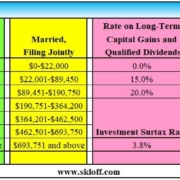How the CARES Act Affects Retirement Accounts – Part 4

Money Matters – Skloff Financial Group Question of the Month – July 1, 2020
By Aaron Skloff, AIF, CFA, MBA
Q: We read the article ‘How the CARES Act Affect Retirement Accounts’ Part 1, Part 2. and Part 3. In January of 2020, I took my Required Distribution (RMD) from my IRA and my spouse took her RMD from her inherited IRA. To avoid paying taxes on those withdrawals, can we redeposit those withdrawals into the same respective IRAs?
A: The Problem – IRA Withdrawals Are Taxed
Required Minimum Distributions (RMDs) force you to take withdrawals from your retirement accounts. With few exceptions (e.g.: Roth IRAs) those withdrawals are taxed as income. The SECURE Act requires you to complete your RMDs from your Inherited IRAs within 10 years (under most circumstances), potentially wreaking havoc on your taxes and your investment portfolio. The IRS places a 60 day limit to redeposit IRA withdrawals. In April of 2020, the IRS expanded the redeposit limits to allow withdrawals completed between February 1, 2020 and May 15, 2020 to be redeposited by July 15, 2020. But this does not address RMDs taken from January of 2020 that were not redeposited within 60 days.
The Solution – Redeposit IRA Withdrawals to Avoid Taxes
On June 23, 2020, the IRS issued Notice 2020-51. The Notice provides details on how you can redeposit RMDs under the Coronavirus Aid, Relief, and Economic Security (CARES) Act. Under the CARES Act certain 2020 RMDs already taken can be redeposited to a retirement account as a rollover. Under the CARES Act, RMDs taken in 2020 are not required.
The Notice provides details on how RMDs from Traditional IRAs and Inherited IRAs to be redeposited (“repayment”), even if the repayment is made more than 60 days after the distribution, provided the repayment is made no later than August 31, 2020.
The repayment will be treated as a rollover but will not be treated as a rollover for purposes of the one rollover per 12-month period limitation nor the restriction on rollovers for non-spousal beneficiaries.
Estate, Financial, Retirement and Tax Planning Opportunities – Do Not Pass Up an Opportunity
Consider redepositing your RMDs, then completing an in-kind Roth IRA Conversion in lieu of an RMD. The CARES Act provides a one-time opportunity to substitute RMDs with Roth IRA conversions. Assets that would normally be permanently forced out of retirement accounts due to RMDs can instead be converted to Roth IRAs.
By proactively taking advantage of temporary depressed stock prices and converting them into a Roth IRA, you turn stock market pain into your gain. The benefits include
1. Locking in Tax Free Growth. Once inside a Roth IRA, all gains and withdrawals for owners and beneficiaries are tax free.
2. Locking in Lower Income Tax Brackets. Married couples can convert at historically low income tax brackets versus future brackets that are expected to be higher (taxpayers will ultimately have to pay for all this tax relief with higher tax rates), when higher RMDs increase their income. A single filer or surviving spouse can have much higher tax brackets for the same amount of income as a married couple. Many Inherited IRA owners are in their peak income years when they are forced to withdraw the entire account value within 10 years. Withdrawals from pre-tax inherited retirement accounts can push them into even higher tax brackets. But withdrawals from inherited Roth IRAs are tax free.
Action Step — Work Closely with a Registered Investment Adviser (RIA) to Best Utilize the CARES Act
Work closely with an RIA to utilize the estate, financial, retirement and tax benefits provided by the CARES Act.
Aaron Skloff, Accredited Investment Fiduciary (AIF), Chartered Financial Analyst (CFA), Master of Business Administration (MBA) is CEO of Skloff Financial Group, a Registered Investment Advisory firm specializing in financial planning, investment management and benefits for small to middle sized companies. He can be contacted at www.skloff.com or 908-464-3060.













